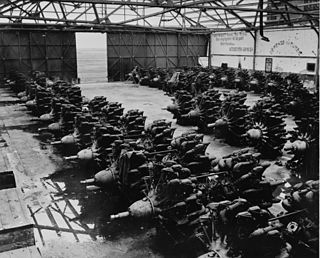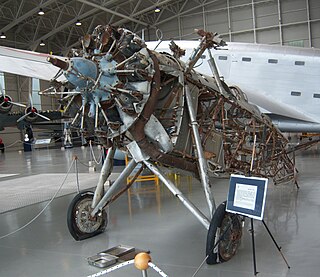
The Caproni Campini N.1, also known as the C.C.2, is an experimental jet aircraft built in the 1930s by Italian aircraft manufacturer Caproni. The N.1 first flew in 1940 and was briefly regarded as the first successful jet-powered aircraft in history, before news emerged of the German Heinkel He 178's first flight a year earlier.

Caproni, also known as Società de Agostini e Caproni and Società Caproni e Comitti, was an Italian aircraft manufacturer. Its main base of operations was at Taliedo, near Linate Airport, on the outskirts of Milan.

The Daimler-Benz DB 601 was a German aircraft engine that was built during World War II. It was a liquid-cooled inverted V12, and powered the Messerschmitt Bf 109, Messerschmitt Bf 110, and many others. Approximately 19,000 601s were produced before it was replaced by the improved Daimler-Benz DB 605 in 1942.

The Delta was a 12-cylinder inverted-V aircraft engine built by Isotta Fraschini prior to and during World War II.

The Gnome-Rhône 14K Mistral Major was a 14-cylinder, two-row, air-cooled radial engine. It was Gnome-Rhône's major aircraft engine prior to World War II, and matured into a highly sought-after design that would see licensed production throughout Europe and Japan. Thousands of Mistral Major engines were produced, used on a wide variety of aircraft.

The Breda Ba.201 was an Italian dive bomber designed during World War II, that never entered production.

The Caproni Vizzola F.5 was an Italian fighter aircraft that was built by Caproni. It was a single-seat, low-wing cantilever monoplane with retractable landing gear.
The Piaggio P.32 was an Italian medium bomber of the late 1930s, produced by Piaggio, and designed by Giovanni Pegna. It was a modern design for its time, but was a failure due to lack of powerplants commensurate with its high wing loading.

The Caproni Ca.355 Tuffo was a low-wing single-engine dive bomber, designed and built by the Italian Caproni company in 1941, which never proceeded beyond a single prototype. Derived from Ca.335 Mistral, the Ca.355 was proposed to equip the Regia Aeronautica, but it was found to offer little advantage over the German Junkers Ju 87 "Stuka" and the project was abandoned.

The Caproni Vizzola F.4 was an Italian fighter aircraft prototype that was designed in 1937 and built from 1939. It was a single-seat, low-wing cantilever monoplane with retractable landing gear.

The Caproni Vizzola F.6 was a World War II-era Italian fighter aircraft built by Caproni. It was a single-seat, low-wing cantilever monoplane with retractable landing gear. Only two prototypes were built, one designated F.6M and the other designated F.6Z.

The Caproni Ca.331 Raffica was an Italian aircraft built by Caproni in the early 1940s as a tactical reconnaissance aircraft/light bomber and also as a night fighter.

The Asso XI was a family of water-cooled, supercharged V12 piston aeroengines produced in the 1930s by Italian manufacturer Isotta Fraschini, and fitted on a number of aircraft types built by CANT, Caproni and others.
The Caproni Ca.350 was an Italian single-engined project for a two-seat fighter-bomber/reconnaissance aircraft of the 1930s. Designed by Cesare Pallavicino to meet a requirement of the Regia Aeronautica, it was an innovative and fast design, to have been powered by an Isotta Fraschini Zeta R.C.42, but no aircraft were built.

The Reggiane Re.2004 was an Italian single-engined monoplane made by Reggiane and designed by Roberto Longhi. The aircraft never passed the preliminary stages.

The Isotta Fraschini Gamma was an air cooled aircraft engine developed by the Italian engineering company Isotta Fraschini in the 1930s. It was an inverted V12 rated at over 500 hp (373 kW). Produced in small numbers for one-off aircraft, including the Ambrosini SAI.107 and Caproni Vizzola F.5 Gamma fighter trainer prototypes, it was developed into the more powerful and more numerous Delta.

The Isotta Fraschini Beta was an air cooled aircraft engine produced by the Italian engineering company Isotta Fraschini in the 1940s. Isotta Fraschini derived the Beta inverted 6-cylinder in-line aircraft engine from the V-12 Gamma. The engine saw limited production for aircraft, including the Nardi FN.316 and Ambrosini SAI.7, but was generally unsatisfactory in service.

The Isotta Fraschini Asso 750 was an Italian W 18 water-cooled aircraft engine of the 1930s. Produced by Isotta Fraschini the engine displaced just under 48 L (2,900 cu in) and produced up to 940 hp (700 kW). Together with the Asso 200 and the Asso 500 the Asso 750 was part of a family of modular engines, that used common and interchangeable components to lower production costs.

The Piaggio P.IX, or Piaggio Stella P.IX, was an Italian nine-cylinder radial aircraft engine produced by Rinaldo Piaggio S.p.A. Based on the Gnome-Rhône 9K, the engine was rated at 600 hp (447 kW). Production was used to power a number of other aircraft developed in Italy. The main users were the Savoia-Marchetti SM.81 transport and the IMAM Ro.37bis, the main reconnaissance aircraft in the Regia Aeronautica during the Second Italo-Ethiopian War, Spanish Civil War and Second World War, but the engine was also used by other designs, including the prototype Savoia-Marchetti SM.79.

The Astro 7 was a seven-cylinder radial aircraft engine built by Isotta Fraschini in the 1930s.


















